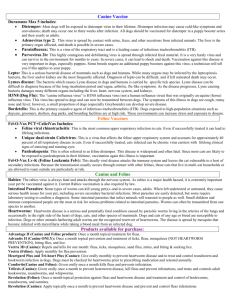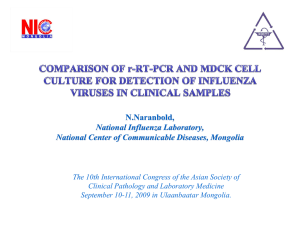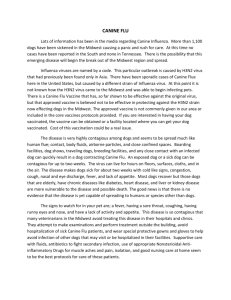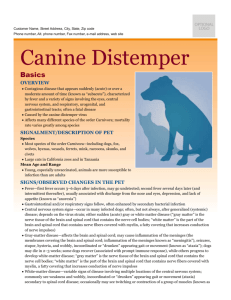Canine Respiratory Disease Complex
advertisement
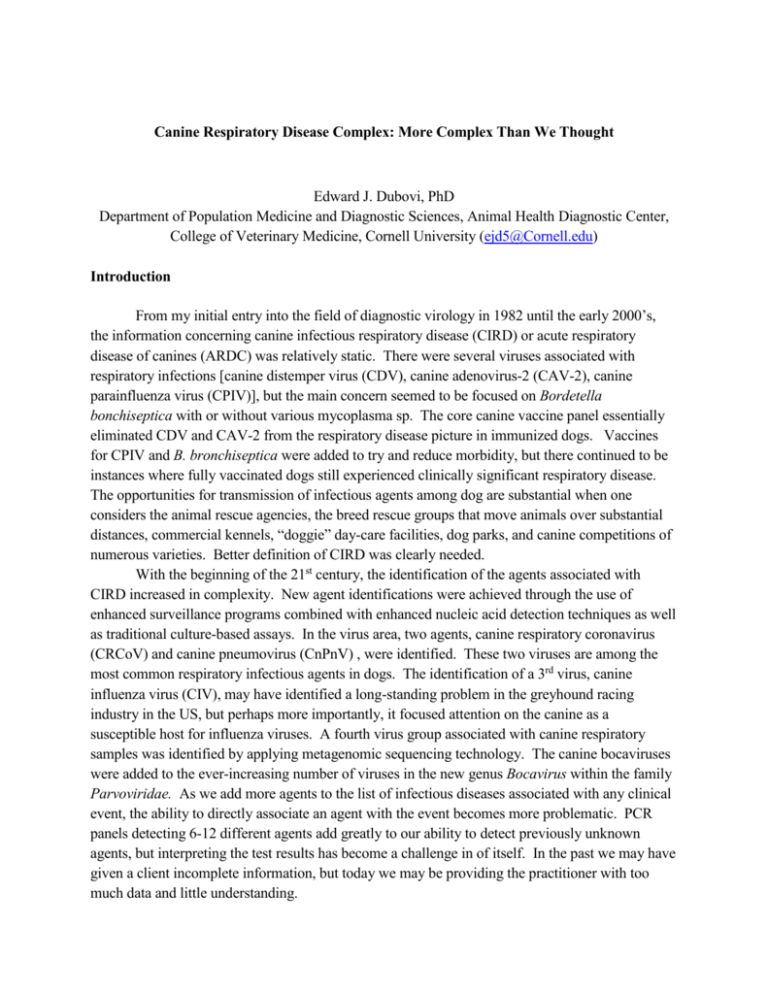
Canine Respiratory Disease Complex: More Complex Than We Thought Edward J. Dubovi, PhD Department of Population Medicine and Diagnostic Sciences, Animal Health Diagnostic Center, College of Veterinary Medicine, Cornell University (ejd5@Cornell.edu) Introduction From my initial entry into the field of diagnostic virology in 1982 until the early 2000’s, the information concerning canine infectious respiratory disease (CIRD) or acute respiratory disease of canines (ARDC) was relatively static. There were several viruses associated with respiratory infections [canine distemper virus (CDV), canine adenovirus-2 (CAV-2), canine parainfluenza virus (CPIV)], but the main concern seemed to be focused on Bordetella bonchiseptica with or without various mycoplasma sp. The core canine vaccine panel essentially eliminated CDV and CAV-2 from the respiratory disease picture in immunized dogs. Vaccines for CPIV and B. bronchiseptica were added to try and reduce morbidity, but there continued to be instances where fully vaccinated dogs still experienced clinically significant respiratory disease. The opportunities for transmission of infectious agents among dog are substantial when one considers the animal rescue agencies, the breed rescue groups that move animals over substantial distances, commercial kennels, “doggie” day-care facilities, dog parks, and canine competitions of numerous varieties. Better definition of CIRD was clearly needed. With the beginning of the 21st century, the identification of the agents associated with CIRD increased in complexity. New agent identifications were achieved through the use of enhanced surveillance programs combined with enhanced nucleic acid detection techniques as well as traditional culture-based assays. In the virus area, two agents, canine respiratory coronavirus (CRCoV) and canine pneumovirus (CnPnV) , were identified. These two viruses are among the most common respiratory infectious agents in dogs. The identification of a 3rd virus, canine influenza virus (CIV), may have identified a long-standing problem in the greyhound racing industry in the US, but perhaps more importantly, it focused attention on the canine as a susceptible host for influenza viruses. A fourth virus group associated with canine respiratory samples was identified by applying metagenomic sequencing technology. The canine bocaviruses were added to the ever-increasing number of viruses in the new genus Bocavirus within the family Parvoviridae. As we add more agents to the list of infectious diseases associated with any clinical event, the ability to directly associate an agent with the event becomes more problematic. PCR panels detecting 6-12 different agents add greatly to our ability to detect previously unknown agents, but interpreting the test results has become a challenge in of itself. In the past we may have given a client incomplete information, but today we may be providing the practitioner with too much data and little understanding. CIRD and the “New” Viral Agents. Canine Influenza Virus A. Nomenclature A discussion of “canine influenza virus” must begin with the issue of nomenclature. Unfortunately, journals are being a bit “sloppy” in permitting the use of the term “canine influenza virus (CIV)”. There are those who apply this term to any influenza virus isolated from a canine source. Clearly a dog can have a disease referred to as canine influenza, but not all influenza viruses isolated from dogs are CIV. A simple example of this would be the isolation of influenza A (H1N1)pdm09 from a dog. This should never be referred to as a canine influenza virus. At least two criteria that should be met before an influenza virus is linked to a host species by name – natural transmission among the members of the species and sequence differences consistently found in the virus that are significantly different from influenza viruses found in other species. B. History a. b. c. d. e. C. Virus a. H3N8, b. c. d. Impetus for investigation was recurrent epizootics of respiratory disease in racing greyhounds in spite of standard vaccination program. March 2004, agent isolated from lung tissue from outbreak in FL1 Genotyping identified the agent as an influenza virus closely linked to the equine H3N8. Frozen lung tissue from 2003 also grew H3N8 virus. Serology data indicates virus existed in canines by 1999. Genotyping indicated 2004 virus with direct lineage to equine influenza virus Florida Clade 1. At least 5 changes in HA are a marker for “canine influenza virus”. CIV can be transmitted from dog to dog. All evidence to date indicates a single lineage for CIV, i.e. single introduction into dogs with all isolates related to this initial introduction. D. Prevalence a. Antibody prevalence in general canine population of US is low. 1. Some confusion may exist with serology testing as equine influenza virus can infect dogs with seroconversion, but no transmission. b. Virus is enzootic in very defined areas with sporadic outbreaks linked to dogs moving from the enzootic areas. Avian-Origin H3N2 Influenza Virus A. History a. First published report of avian-lineage H3N2 in dogs from Korea in 2008 from cases detected in 20072. b. c. B. Virus a. b. c. d. e. Subsequent report from southern China identified avian lineage H3N2 in dogs in 20063. In 2012-2013 numerous reports from China of canine infections by H3N2. All H3N2 isolates from canines have 8 genes derived from avian isolates. Virus most likely introduced into dogs in animal markets. Single or multiple introductions? When? Limited data on whether viruses are “true” canine viruses or simply avian isolates capable of causing disease in dogs. Transmission from dog to dog occurs and the virus has been identified in felines. Canine Respiratory Coronavirus A. Nomenclature a. A brief description of the changing nomenclature in the family Coronaviridae as it relates to current and past isolates from dogs will be attempted. B. History a. b. c. C. Virus a. b. c. d. Surveillance program established at the Royal Veterinary College to define CIRD in a “rehoming” facility chronically experiencing outbreaks of respiratory disease. RT-PCR assays attempted for major viral species4. A group II (beta) coronavirus identified in samples from dogs with respiratory infections. Beta coronavirus with sequence similarity to bovine coronavirus of >95%. Very low genetic similarity to the alpha coronaviruses previously identified in dogs. CRCoV can be cultured in vitro but not easily. Isolated virus produces mild respiratory infections with infection of respiratory epithelium5. D. Prevalence a. Virus has world-wide distribution. b. Antibody prevalence rates in US-UK >50%. c. RT-PCR detection rates in US of 10-25% in dogs showing respiratory signs. Canine Pneumovirus A. History a. Virus identified in 2008 as part of a surveillance program on the cause of respiratory infections occurring on in-take at a rescue shelter6. B. Virus a. b. c. d. e. C. Prevalence a. b. c. d. Member of the genus Pneumovirus. Only known related virus is pneumonia virus of mice (PVM). Genetic sequence >95% similar to PVM. Antisera specific for PVM will neutralize CnPnV. Is there a real difference between PVM and CnPnV? Virus has worldwide distribution. 1. Ab+ serum from EU, Africa and India. In cases of respiratory disease, an RT-PCR rate of ~25% has been found. Antibody prevalence rates of 25-60%. Ab+ sera from dogs back to 1999 – earliest sera available. Canine Bocaviruses A. History a. Bocaviruses are small DNA viruses in the family Parvoviridae. 1. Numerous bocaviruses have been identified in humans, marine mammals, primates, and food animals. 2. Minute virus of canines now classified as a bocavirus. b. Bocavirus associated with canine respiratory cases identified in 20117. c. Guilt by association? References 1. Crawford PC, Dubov, EJ, Castleman WL, Stephenson I, et al. 2005. Interspecies transmission of equine influenza virus to dogs. Science, 310:482-485. 2. Song, D., Kang B, Lee C, Jung K, et al. 2008. Transmission of avian influenza virus (H3N2) to dogs. Emerg Infect Dis 14:741-746. 3 Shoujun L, Zhihai S, Peirong J, Guihong Z, et al. 2010. Avian-origin H3N2 canine influenza A viruses in Southern China. Infect Genetics Evol 10:1286-88. 4. Erles K, Toomey C, Brooks HW, Brownlie J. 2003. Detection of a group 2 coronavirus in dogs with canine infectious respiratory disease. Virology 310:216-23. 5. Mitchel JA, Boooks Hw, Szladovits B, Erles K, et al. 2013. Tropism and pathological findings associated with canine respiratory coronavirus (CRCoV). Vet Microbiol 162:58294. 6. Renshaw RR, Zylich NC, Laverack MA, Glaser AL, Dubovi EJ. 2010. Pneumovirus in dogs with acute respiratory disease. Emerg Infect Dis 16:993-5. 7. Kapoor A, Mehta N, Dubovi EJ, Simmonds P, et al. 2012. Characterization of novel canine bocaviruses and their association with respiratory disease. J Gen Virol 93:341-6.

